Nantwich
OS Grid ref:- SJ652523
The Cheshire market town of Nantwich has a long hstory and was founded in Roman times. It is mentioned in the the Domesday Book of 1087, where it is recorded as having eight salt houses and was once the capital of the barony of the Earls of Chester.
The town square
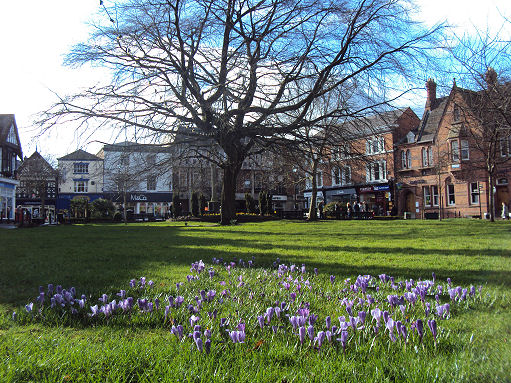
Nantwich became a thriving salt-producing centre from the tenth century or even earlier. In the Middle Ages, Nantwich was the most important salt town in Cheshire. The salt industry in Nantwich peaked in the mid-sixteenth century, with around 400 salt houses in 1530, and had almost died out by the end of the eighteenth century; the last salt house closed in the mid-nineteenth century. A Norman castle once stood at the crossing of the Weaver, nothing remains of the castle above ground today.
Nantwich suffered a major fire in 1583, which destroyed most of the town to the east of the Weaver. The then reigning monarch, Queen Elizabeth I, personally contributed to the town's rebuilding, which followed the plan of the destroyed town. Beam Street, one of the Nantwich's main streets, was re-named to reflect the fact that the timber to rebuild the town was transported along it.
High Street, Nantwich
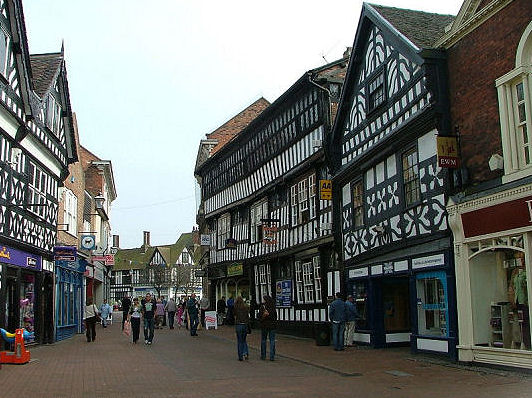
During the English Civil War the town supported Parliament and was consequently besieged several times by the Royalists. The final, six-week long, siege was lifted following the victory of the Parliamentary forces in the Battle of Nantwich on 26th January 1644. By holding out against the Royalist siege until the arrival of General Fairfax, Nantwich helped to ensure Parliamentary victory in the North West. The battle is re-enacted every year since 1973 on Holly Holy Day, on which day the town is filled with Roundheads, Cavaliers, camp followers, fire eaters and other entertainers of the period, and a festive atmopshere fills the streets.
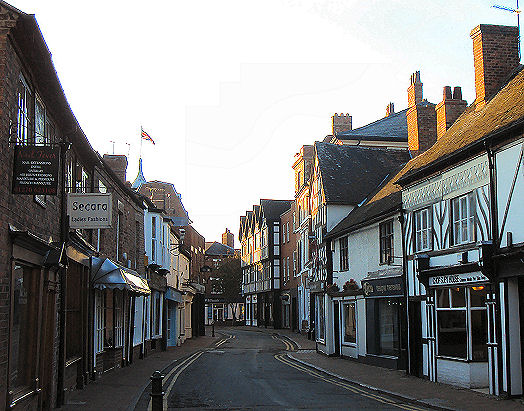
Next to the city of Chester, Nantwich has the largest number of historic buildings in Cheshire. The largest majority of these are located within a conservation area, which follows the boundaries of the late medieval and early post-medieval town. Sweetbriar Hall and Churche's Mansion are both timber-framed, Elizabethan mansion houses. The Crown Hotel, a timber framed building with continuous glazing on the upper storey, is a Grade II listed building and has stood in the town for over 400 years. It was once a coaching stop on the London-Chester run. The building was burnt down in the fire of Nantwich in 1583 and was rebuilt with timbers from Delamere Forest. The long, enclosed gallery on the first floor is an unusual feature. In the Cocoa Yard is a chimney that survives from an ninetenth century wheelwright's forge and smithy.
46 and 48 High Street
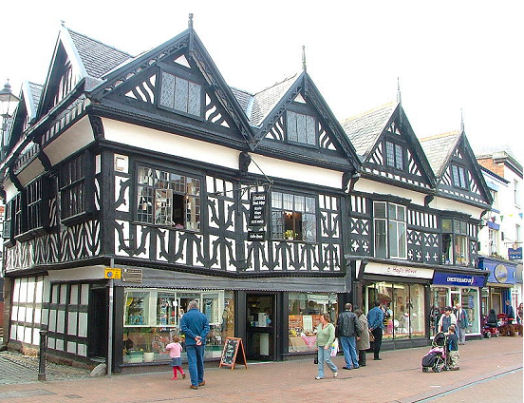
Nantwich Museum is located in the Town Square. It has galleries on the history of the town, including Roman salt making, Tudor Nantwich's Great Fire, the Civil War Battle of Nantwich and the more recent shoe and clothing industries.
St. Mary's Church, Nantwich
The red sandstone St Mary's Church, which is of fourteenth century origin, is known locally as the 'Cathedral of South Cheshire'. Built on the grand scale with an octagonal tower it has significant features in common with the cathedrals at Lichfield, Chester, Gloucester and Wells.
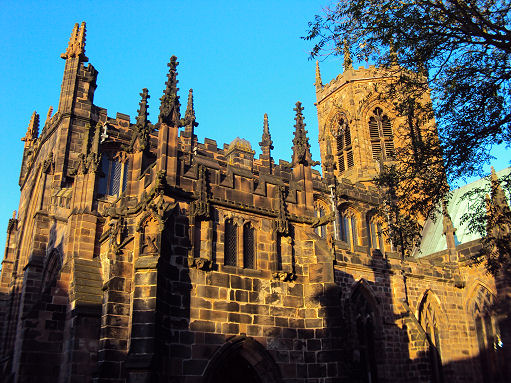
The church boasts twenty late fourteenth century misericords with a variety of weird and wonderful carvings.
The octagonal tower
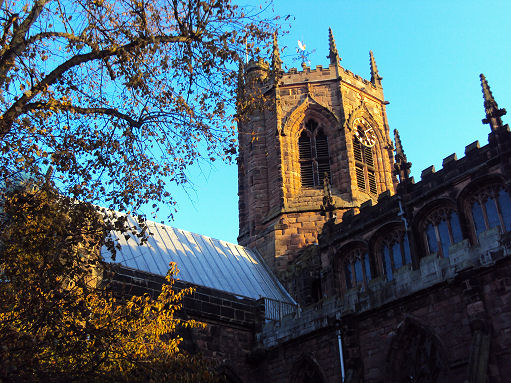
Interesting features of the church's interior include the fourteenth century lierne-vaulted ceiling of the choir, the carved stone canopies of the sedilia in the chancel, and the exquisite and intricately carved wooden canopies over the choirstalls. The church boasts twenty late fourteenth century misericords with a variety of weird and wonderful carvings. The north wall of the north transept contains a window with stained glass by Kempe which incorporates some pieces of medieval glass and depicts the Tree of Jesse.
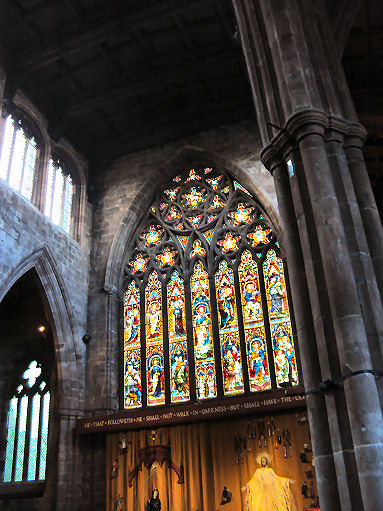
A Jacobean stone pulpit is situated in the nave, designed by Thomas Finch and made in 1601, it was once part of a three-decker pulpit. It was damaged in 1683 by a falling roof beam and was reduced in the 1855. A second pulpit, made of stone and dating from the late fourteenth century, is attached to the northeast pier of the crossing. This is designed to appear like a large chalice, and is decorated with panel tracery.
14th century stone pulpit
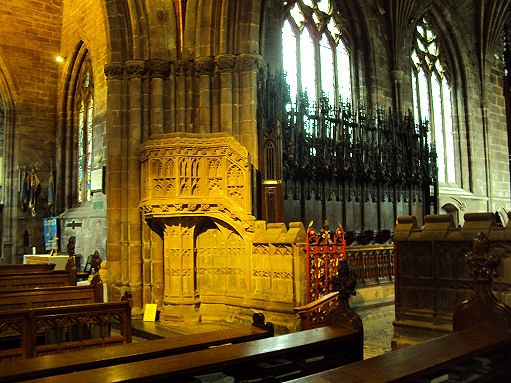
An alabaster effigy of Sir David Craddock, who died in about 1384, is situated in the south transept. The effigy was damaged during the Civil War, and was discovered buried under the chancel floor during the nineteenth century restoration of the building. Sir David, who came from Nantwich, was once Mayor of Bordeaux, Justicar of Wales and a money-lender to King Richard II. The south transept also contains a large tomb, dated 1614, which was transferred from the former St Chad's Church, Wybunbury in 1982. This is constructed of alabaster and limestone and includes effigies of Sir Thomas Smith, mayor and sheriff of Chester, and his wife, Anne.
Alabaster effigy of Sir Thomas Smith, mayor of Chester and his wife Anne
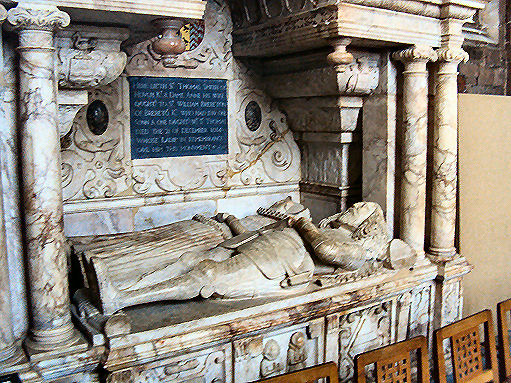
The fourteenth century chancel ceiling consists of a stone lierne vault with almost 70 carved bosses. The eastern bosses depict the life of Mary and the western ones Christ's Passion and Resurrection.
The stone vaulted chancel ceiling
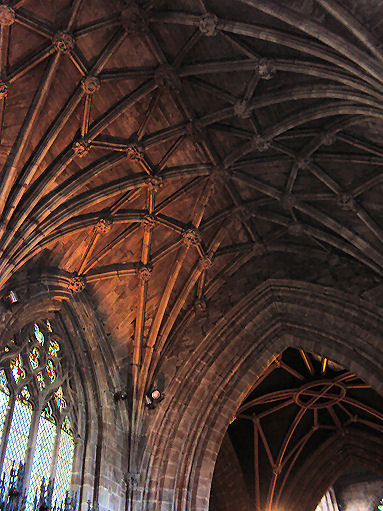
The chancel contains superb intricately carved choirstalls, above each choirstall is a carved triple-arched canopy. The canopies are described as having "a complexity unsurpassed in English medieval woodcarving". Clifton-Taylor considered that they are the finest in the country, although he complained that they have been stained nearly black. At the lower ends of the canopies are Victorian carvings of angels, grotesques and foliage and below these are carvings on corbels of subjects such as mermaids, centaurs, wyverns and musical angels. At the back of the choirstalls are 20 misericords which date from the early-mid fifteenth century.
Choir Stalls with intricate carvings and canopies
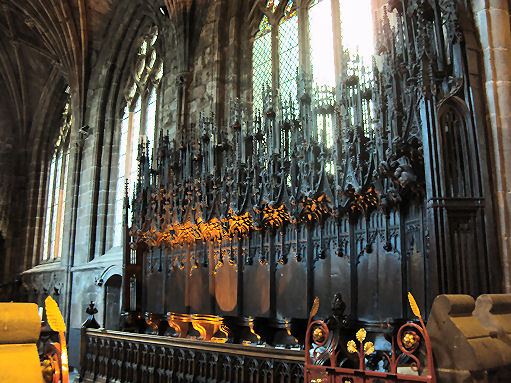
Nearby places of interest
Dorfold Hall, a grade I listed Jacobean mansion, is situated in the village of Acton, a mile to the west of Nantwich .
Bridgemere Garden World, covering fifty acres and Britain's largest garden centre, is located south of Nantwich and lies on the beautiful borders of Cheshire, Staffordshire and Shropshire. A gardener's paradise, the centre makes a great day out for the enthusiast.
The Anderton Boat Lift, the world's first and England's only boat lift. Dating from 1875, the Anderton Boat Lift is one of the greatest monuments to Britain's canal age and known as the "Cathedral of the Canals". It provides a fifty foot vertical link between two navigable waterways: the River Weaver and the Trent and Mersey Canal.
Back to Cheshire towns and villages
